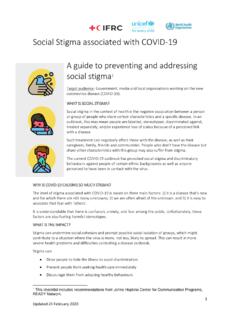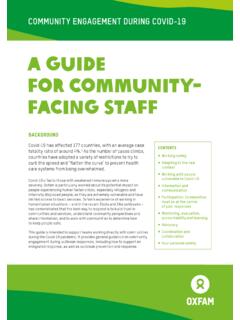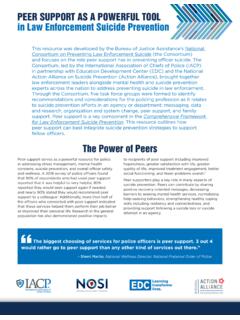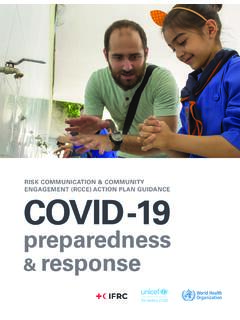Transcription of Saving Lives, Protecting Societies, Recovering Better
1 1 United Nations Comprehensive Response to C OV I D -19 Saving Lives, Protecting Societies, Recovering BetterSeptember 2020 2 Credits This document is produced by the United Cover On 31 March 2020, a seven-year-old child is given a protective mask by INTERSOS/UNICEF outreach worker, prior to a health screening in the informal settlement in Rome, Italy, where she lives. Credit: Design UN Office for the Coordination of Humanitarian Affairs AHOYThe designations employed and the presentation of material in this publication do not imply the expression of any opinion whatsoever on the part of the Secretariat of the United Nations concerning the legal status of any country, territory, city or area or of its authorities, or concerning the delimitation of its frontiers or boundaries.
2 3 Contents 4 EXECUTIVE SUMMARY 11 UNITED NATIONS SYSTEM COMPREHENSIVE RESPONSE TO COVID-19 15 THE HEALTH RESPONSE 26 SAFEGUARDING LIVES AND LIVELIHOODS 27 WE ARE ALL IN THIS TOGETHER 42 ATTENTION TO HARDEST HIT POPULATIONS 57 REGIONAL CHALLENGES AND SPECIFICITIES 62 A Better POST-COVID WORLD 67 MOBILIZING RESOURCES AND PARTNERS TO SUPPORT COUNTRIESE xecutive Summary Food distribution of WFP in Bangladesh, Cox's Bazar, 21 May 2020 . Credit: WFP/Nihab RahmanA THREE-POINT UNITED NATIONS SYSTEM RESPONSE 6 SHAPING THE GLOBAL RESPONSE 7 SUPPORTING THE DELIVERY OF THE RESPONSE AT NATIONAL LEVEL 8 FUNDING THE RESPONSE 9 SUSTAINING THE RESPONSE 10 ExEcutivE Summary5 Over the course of 2020, the coronavirus disease, or COVID-19, has taken hundreds of thousands of lives, infected millions of people, upended the global economy and cast a dark shadow across our future.
3 No country has been spared. No population group remains unscathed. Nobody is immune to its the outset of the pandemic, the United Nations system mobilized early and com-prehensively. It led on the global health re-sponse, provided life- Saving humanitarian assistance to the most vulnerable, established instruments for rapid responses to the so-cio-economic impact and laid out a broad policy agenda for action on all fronts. It also provided logistics, common services and op-erational support to governments and other partners around the world on the front lines of the pandemic, as they mounted national re-sponses to this new virus and unprecedented global , six months since the pandemic was de-clared, we issue this updated, comprehensive overview of the UN system response.
4 The over-view recounts our key guidance, lessons and support in the first six months of the pandemic and points the way to the crucial steps that must follow to save lives, protect societies and recover Better , leaving no one behind and addressing the very fragilities and gaps that made us so vulnerable in the first place. It also points the way toward addressing future shocks above all from climate change and toward overcoming the severe and systemic inequalities that have been so tragically ex-posed and exacerbated by the pandemic. It became clear early on that the pandemic was more than a health crisis; it is a socio-eco-nomic crisis, a humanitarian crisis, a security crisis, and a human rights crisis. It has affect-ed us as individuals, as families, communities and societies.
5 It has had an impact on every generation, including on those not yet born. The crisis has highlighted fragilities within and among nations, as well as in our systems for mounting a coordinated global response to shared threats. Our response will there-fore also need to engender a deep reflection on the very structures of societies, both na-tionally and internationally, and the ways in which countries cooperate for the common Secretary-General Ant nio Guterres (left) speaks with Deputy Secretary-General Amina Mohammed ahead of participating in the high-level virtual event on Financing for Development in the Era of COVID-19 and Beyond. Credit: UN Photo/Evan SchneiderExEcutivE Summary 6good. Coming out of this crisis will require a whole-of-society, whole-of-government and whole-of-the-world approach driven by com-passion and THREE-POINT UNITED NATIONS SYSTEM RESPONSEThe United Nations response to COVID-19 and its impact has three overarching components: 1.
6 A large-scale, coordinated and compre-hensive health response, guided by the World Health Organization (WHO) and its Strategic Preparedness and Response Plan, which aims to mobilize all sectors and communities in the response, control and suppression of the transmission of the virus, reduce mortality by providing care for those affected, and develop safe and effective vaccines and therapeutics that can be delivered at scale and that are accessible based on need. A world where COVID-19 is no longer a threat to humanity requires the most massive public health effort in history, that recognizes universal access to health as a critical global public good. Part of this response is a new global collaboration the Access to COVID-19 Tools (ACT) Accelerator the aim of which is to accelerate develop-ment, production, and equitable access to COVID-19 tests, treatments, and vaccines.
7 The UN has also provided international coordination and operational support at the global, regional and country level, and supported the scaling up of country prepar-edness and response A wide-ranging effort to safeguard lives and livelihoods by addressing the devastating near-term socio-economic, humanitarian and human rights aspects of the crisis with attention to those hit hardest. The focus is on Saving lives, keeping vital services accessible, households afloat, businesses solvent, supply chains functioning, insti-tutions strong, public services delivering and human rights at the forefront. This is achieved through immediate humanitar-ian support to the hardest-hit population in the most vulnerable 63 countries with life- Saving assistance through a Global Humanitarian Response Plan (GHRP), as well as support to more than 120 countries for an immediate socio-economic response guided by the UN development system framework.
8 At global level, it includes the policy agenda contained in the series of policy briefs, as well as strong advocacy for support to developing countries, including a debt standstill, debt restructuring and great-er support through the international finan-cial institutions. preventing and responding to the increased levels of violence against women and girls is also a critical feature. 3. A transformative recovery process that leads to a Better post-COVID-19 world by ad-dressing underlying fragilities and identify-ing opportunities for transformative change towards more just, equal and resilient societies and economies. Emerging from this crisis is an opportunity to address the climate crisis, inequalities, exclusion, gaps in social protection systems and the many other injustices that have been exposed and exacerbated.
9 Instead of going back to unsustainable systems and approaches, we need to transition to renewable energy, sustainable food systems, gender equality, stronger social safety nets, universal health coverage and an international system that can deliver consistently, effectively and uni-versally with the Sustainable Development Agenda as our guide. ExEcutivE Summary7 In order to enable this response and to cre-ate the conditions in which all people es-pecially those in precarious situations can be reached, the Secretary-General has also strongly advocated for the following: Global ceasefire and diplomacy: The Secretary-General s call for a global cease-fire, issued on 23 March, urged warring parties around the world to pull back from hostilities to facilitate the delivery of human-itarian assistance and open the windows for diplomacy.
10 The appeal resonated widely and was endorsed by 180 Member States and one non-Member Observer State, over 20 armed movements and other entities, diverse regional organizations, religious leaders, NGOs and more than 800 civil so-ciety organizations. On 1 July, the Security Council adopted resolution 2532 calling for a 90-day humanitarian pause for all armed conflicts, with the exception of military operations conducted in the context of counter-terrorism operations. UN Special Representatives and Envoys continue their efforts to translate stated intentions into durable ceasefires and to pursue lasting political solutions. On 5 April, noting that violence was not con-fined to the battlefield, the Secretary-Gener-al issued a global call emphasizing the need for an end to all violence against women everywhere, including in the home.

















